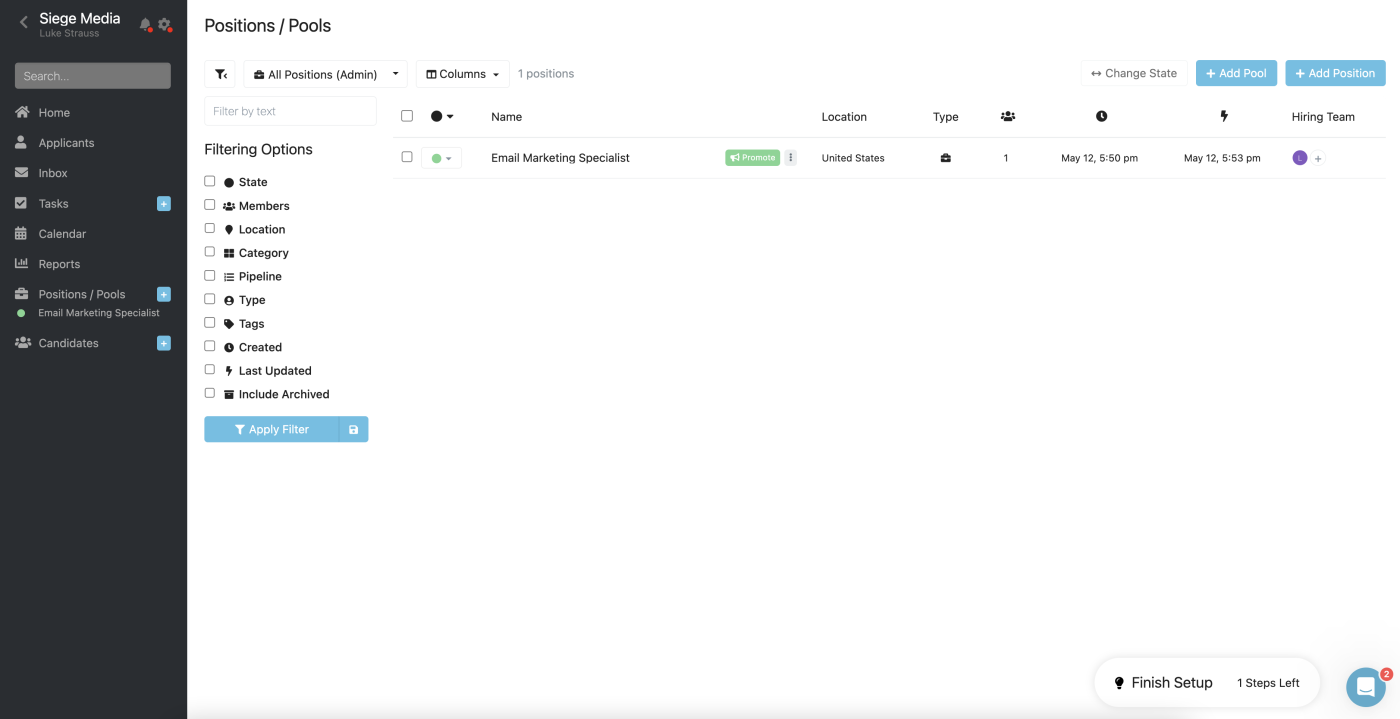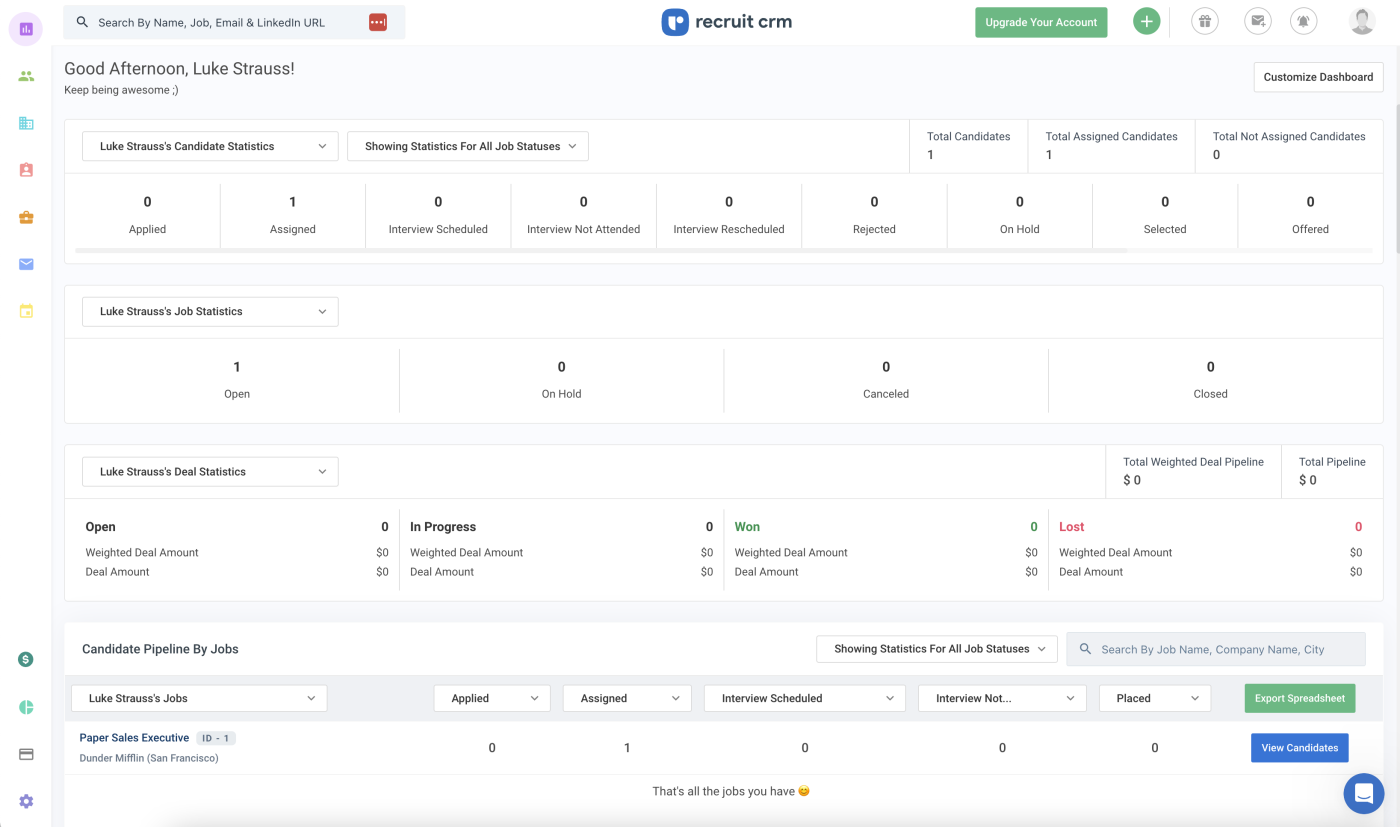When you open the floodgates that are a new job posting, you have to be ready for the wave of candidates that can follow. It's not easy to sort through hundreds or thousands of applicants to find those best fit for the job—which is why the agency I work for uses an applicant tracking system (ATS) to manage the best possible talent pipeline.
To help you pick the best solution for your organization, I researched several dozen ATS platforms, testing all of the top contenders over the course of several weeks.
The good news: there are a lot of great options out there, many of which have unique features that will help you streamline your applicant tracking. With that, here are the eight best applicant tracking systems based on my experiences with them.
The 8 best applicant tracking systems
Workable for candidate tracking
Breezy HR for small businesses on a budget
Pinpoint for a premium experience
Zoho Recruit for AI features
Greenhouse for reporting
BambooHR for full HR integration
Recruit CRM for recruiting agencies
JazzHR for user-friendliness
What makes the best applicant tracking system?
How we evaluate and test apps
Our best apps roundups are written by humans who've spent much of their careers using, testing, and writing about software. Unless explicitly stated, we spend dozens of hours researching and testing apps, using each app as it's intended to be used and evaluating it against the criteria we set for the category. We're never paid for placement in our articles from any app or for links to any site—we value the trust readers put in us to offer authentic evaluations of the categories and apps we review. For more details on our process, read the full rundown of how we select apps to feature on the Zapier blog.
Whether you're a startup newly branching out from your founding members or an established company that's been managing job candidates in a spreadsheet (yikes), it's time to explore the applicant tracking systems out there. ATS offerings have drastically advanced in recent years, but there are some features that every ATS needs to be considered worthy of your (and your candidates') time.
Here's what I was looking out for as I tested:
Automation tools: Recruiting and applicant tracking requires pretty repetitive processes: collecting candidates, scoring them, categorizing them in pools, and sending progression and rejection emails, to name a few. Software that automates these processes through workflow automation rules and template options will free up your team's time to focus on identifying the best fit for your open roles.
Candidate tracking features: You would think that every ATS would knock tracking out of the park, but you'd be surprised. Some systems offer far more advanced candidate data management and search capabilities, with features such as advanced search, tags, hotlists/candidate pools, and more. Every platform on this list has solid tracking features that shine through the noise.
Integrations: Your applicant tracking system should natively integrate with job boards like LinkedIn, Indeed, and ZipRecruiter, enabling you to quickly post your open positions to these boards and source candidate details from third-party sites. All the better if your system integrates with other apps you use for creating a complete recruiting, onboarding, and HR machine.
User-friendliness: How intuitive is your system? Does its interface make sense (categorized tabs, logical placement of items), make it easy to navigate several candidates and job postings (including consolidated views of important notes), and anticipate your needs?
Customization options: Every job at every organization is different, which may require custom workflows. A flexible system helps teams build processes that work for them rather than locking them into a strict workflow. Can you create multiple custom pipelines that your candidates will progress along, depending on the job they're applying for? Can you save custom views to see the candidate's most important details? Customization in these areas goes a long way.
Reporting and analytics: Applicant tracking systems are a bit hit-or-miss when it comes to reporting. All the apps in this roundup offer reporting and analytics, but some stand out above the rest by offering custom reports and dashboards, interactive data visualizations, and several prebuilt reports that shed light on important areas of company success.
I used these criteria in addition to my experience extensively exploring and testing ATS platforms on the market to select eight apps that will facilitate an excellent recruiting and applicant tracking process. To test each app, I signed up, imported sample data, created job postings, and extensively explored the app's interface. Here are my findings.
The best applicant tracking systems at a glance
Best for | Stand-out feature | Pricing | |
|---|---|---|---|
Candidate tracking | Advanced people search | From $129/month, billed monthly, for the Starter plan | |
Small businesses | Free plan with essential features | From $157/month, billed annually, for the Startup plan | |
Premium experience | Highly customizable interface | From $600/month, billed annually, for the Growth plan | |
AI features | Built-in AI assistant | Free with forever free plan; $25/user/month, billed annually | |
Reporting | Interactive data visualizations | Custom | |
Full HR integration | Onboarding, payroll, and other HR features | Custom | |
Recruiting agencies | Chrome extension to extract candidate information | From $85/user/month, billed annually, for the Pro plan | |
User-friendliness | Dynamic guide for job posting | From $49/month, billed annually, for the Hero plan |
Best ATS for candidate tracking
Workable (Web, iOS, Android)

When I first opened Workable, I was met with a guided walkthrough of a major recent feature release that made it a shoo-in for this list.
The advanced People Search feature enables users to search for virtually any detail about a candidate to identify them: previous job title, location, education, you name it. As long as a member of the Hiring team remembers one detail about the candidate, it should be easy to identify them with Workable. This feature is especially helpful for large organizations with a massive candidate pool.
Workable's search functionality is amplified by many candidate filtering and sorting options—far more than I think most teams will need—including creation and disqualification date. Like many other ATS platforms, you can also add custom tags to individuals and filter by those. I was also impressed by the candidate information overview shown before you even click on the candidate: location, pipeline stage, other jobs they've applied for, and even some work experience details.
Apart from its candidate tracking features, Workable has some other advanced features, including solid visual report generation and AI-powered capabilities. For example, it uses AI to generate full job descriptions from a job title alone, and I was honestly highly impressed with the result. Sure, it was a little boilerplate, but it's still a nice time-saving tool for the job description copy that doesn't deserve an hour of your time to write.
Generally, Workable is super easy to use. That said, I did find some tabs (like the activity stream and view of candidates for a specific job) to be a little busy and overwhelming. I'm sure teams could adapt to these views with time, but it detracted from the platform's user-friendliness.
With the help of Zapier, you can connect Workable to all your other apps, so you can do things like send messages to applicants or import applicant information from your favorite spreadsheet apps. Start with one of the examples below, or learn more about how to automate Workable.
Send a Confirmation Email to New Workable Applicants
Use Google Docs/Form to Create Candidates in Workable
Workable price: From $129/month, billed monthly, for the Starter plan
Best ATS for small businesses on a budget
Breezy (Web, iOS, Android)

There aren't too many applicant tracking systems that offer free plans, and most that do either have interfaces that feel like a jump scare or skimp out on a lot of important features. Breezy's Bootstrap plan bucks this trend.
The free plan offers most of the basic features an ATS should have, including unlimited users, custom applications, integrations with popular job boards, including LinkedIn and Indeed, and a comprehensive candidate tracking interface.
Of these features, I was most impressed with the Candidates tab. With a drag-and-drop Kanban view, it was easy to see each candidate's pipeline stage. I could also chat with teammates about candidates and view consolidated reviewer feedback from scorecards.
The interface is also relatively minimalistic and user-friendly. When I first opened the app, I was met with a tutorial bot and an intro video walking through important features of the app's interface.
Plus, even with its free plan, Breezy offers a customizable branded career site where applicants can apply for jobs. I'm no programmer, but the option to add CSS and JavaScript provides more coding-friendly users with nearly endless customization capabilities. If you aren't a coder, the platform provides standard templates you can build on.
Breezy also integrates with Zapier, which means you can do things like get notifications of new candidates via your favorite messaging platforms or automatically generate new candidate-related tasks in your project management tools.
Get notified in Slack of new candidates in Breezy HR
Breezy price: From $157/month, billed annually, for the Startup plan (with first two months free)
Best ATS for a premium experience
Pinpoint (Web)

If one platform could make the work of a hiring specialist enjoyable, it's Pinpoint. For one, the platform is gorgeous and user-friendly. While nearly every feature is consolidated in the left-hand menu bar, it's neatly categorized and easy to navigate.
Pinpoint's candidate tracking interface is highly customizable—you can move candidate widgets around to create views that work for you, showing the details you need to see to effectively evaluate each candidate. It even offers a candidate comparison feature, allowing you to pull up two candidates side-by-side and compare their applications and ratings.
The platform also allows you to create as many hiring workflows as you want, each with up to 25 stages. I found this to be a little overkill—after all, I doubt many organizations will need to create hundreds of 25-stage pipelines for their open positions—but hey, I'm not one to complain about the concept of "unlimited."
One recurring theme that made Pinpoint stand out as a premium solution is its commitment to combating bias. In addition to standard reporting (with beautiful and digestible graphs, might I add), Pinpoint offers "equality monitoring" reports that allow you to view candidate demographic information and candidate experience metrics to improve diversity and overall experience in the workplace.
Pinpoint also offers anonymized screening—a feature that changes candidate names to a combination of random fruits, veggies, and colors to eliminate name bias. This feature also hides information in applications about gender, ethnicity, and other demographic characteristics that could contribute to bias.
Plus, you can use Zapier to connect Pinpoint to thousands of other apps. For example, you can automate tasks like subscribing your Pinpoint talent pipeline to mailing lists in your email marketing platform, or get notifications via Slack when a candidate moves to the next stage of their applicant pipeline.
Subscribe new Pinpoint talent pipeline candidates to mailing lists in Mailchimp
Send direct messages in Slack for when new applications move to new stages in Pinpoint
Pinpoint price: From $600/month, billed annually, for the Growth plan
Best ATS for AI features
Zoho Recruit (Web, iOS, Android)

Zoho is a fan favorite for a variety of cloud-based solutions, including its ATS, Zoho Recruit. Since it natively integrates with all the other apps in the Zoho ecosystem, it's a solid option for teams that are already die-hard Zoho fans.
One area where Zoho stands out most is its built-in AI assistant. Known as Zia, this assistant intelligently compares candidate information to job requirements to generate a rating showing how equipped each candidate is for the job(s) they applied for. It's a solid gut check to quickly rule out candidates who apply without sufficient experience or keep a close eye on candidates that shine.
Zoho's time-saving features don't end there—I was also impressed with its advanced automation options. For example, when a candidate is rejected, you can trigger a rejection email to send them, their status field to update to Rejected, and even activate a webhook. Plus, these actions don't have to occur immediately—you can schedule them to happen days after the candidate is rejected.
This is all on top of the standard ATS features, like career site building, comprehensive job listing customization, and candidate assessment creation.
The biggest downside of the app (which applies to nearly every other app in the Zoho ecosystem) is its interface. It feels outdated, lots of features are hidden behind multiple tabs and require several clicks to access, and text throughout the interface isn't easy to read. But the price point combined with the advanced features makes up for all that.
Plus, since Zoho Recruit integrates with Zapier, you can automate tasks like candidate imports from spreadsheet apps and customer creation in your accounting software. Here are a couple examples, but you can connect Zoho Recruit to any other app in your tech stack using Zapier.
Add candidates to Zoho Recruit from new rows on Google Sheets
Add Zoho Recruit records to QuickBooks Online as customers
Zoho Recruit price: Free with the Forever Free plan; $25/user/month, billed annually, for the Standard plan
Best ATS for reporting
Greenhouse (Web)

Greenhouse stood out to me for several reasons. My first impression was that it's clean, organized, and easy to navigate. As I dug into its features, I became increasingly impressed.
Hands down, Greenhouse has the best reporting of all the ATS platforms I tested. Not only does it provide over 40 pre-made reports to shed light on a variety of important granular insights like pipeline history and candidate quality by source, but it also allows you to generate custom reports with interactive data visualizations.
Each job dashboard also shows data complemented by a color-coordinated donut chart showing the quality of candidates for the job from each source. This makes it easy to identify the highest-performing candidate sources and allocate your budget for job postings accordingly.
And Greenhouse stands out for more than just its reporting. It includes over 450 integration partners and simplifies sharing jobs on social media and popular job boards. For customers with CRM access, it can also automatically source the best email address for a prospect from across the web and add them to the right campaign pool, triggering appropriate catered email sequences.
By integrating Greenhouse and Zapier, you can automate your business-critical workflows, like announcing new applications for pressing job openings and adding application responses to spreadsheet apps.
Share new Greenhouse candidate applications in Slack channels
Add new Greenhouse candidate applications as Excel rows
Greenhouse price: Custom
Best ATS for full HR integration
BambooHR (Web, iOS, Android)

I'll be honest—most ATS software integrated into comprehensive HR platforms had me asking, "that's it?" Most skimp on many candidate sourcing and applicant tracking features to prioritize other areas of HR. BambooHR, while not perfect, breaks the typecast and does a pretty solid job integrating an ATS with other HR tools like employee records, time-off management, payroll, benefits, and onboarding and offboarding.
While you have to upgrade to the Advantage plan to access BambooHR's ATS, it has some solid features. For one, it offers a larger template library than most other ATS platforms, including for acceptance, rejection, interview invites, and reference requests.
It also offers quite a few unique customization options. For example, I was able to specify certain details that collaborators could see about candidates while leaving other sensitive information out. I could also create custom candidate pools for organizing candidates and connecting them to catered email sequences.
My favorite section was the Candidates tab. It offered filters to sort through candidates and provided a quick glimpse of each candidate's most essential information: contact info, status, rating, last email sent between you and them, and more. Plus, since BambooHR is an entire HR software as opposed to just an ATS, once you've sourced and hired new candidates, it's easy to move them into your onboarding process, payroll system, and more—all within the same app.
The biggest area BambooHR seemed to fall short of was reporting. While the platform offered solid reports for most other HR functions and metrics, there were very few options for applicant tracking, and no custom fields catered to this area of HR, either.
By connecting BambooHR with Zapier, it can talk to all your other apps too. Automatically invite new hires to join accounts for your favorite apps or keep track of those hires in spreadsheets. Learn more about how to automate BambooHR.
Invite new employees in BambooHR to join your Zapier team account
BambooHR price: Custom
Best ATS for recruiting agencies
Recruit CRM (Web, iOS, Android)

Recruit CRM was one of the most unique ATS platforms I encountered in that it's an ATS and CRM hybrid built specifically for recruiting firms, executive search firms, and staffing agencies. It's designed to help these organizations capture candidates and pitch them to hiring managers.
The app offers many advanced features and functionalities designed for this purpose. For example, it includes a Google Chrome extension that intelligently extracts candidate information directly from LinkedIn, pulling that data into the system. Once you've captured candidates' resumes, you can format them, hiding information like the candidate's contact information so that hiring managers have to reach out to you (the recruiter) to reach the candidate.
Overall, I found the platform to be super customizable—you can easily edit resumes, drag and drop elements wherever you want them on your dashboard, view your candidate pipelines in Kanban style, and create custom personalized messages for candidates and hiring managers using merge fields.
I'm no head hunter, but if I was, I feel confident that this tool would provide me with everything I'd need to source stellar talent for my clients.
Recruit CRM also integrates with Zapier, so you can automate tasks like adding specific candidates as new employees in your HR platform.
Add newly placed Recruit CRM candidates as BambooHR employees
Recruit CRM price: From $85/user/month, billed annually, for the Pro plan
Best ATS for user-friendliness
JazzHR (Web)

When I saw that JazzHR boasted high rankings for user-friendliness and ease of use, my scrutiny meter naturally shot up. But after testing the tool and comparing it to many ATS platforms, I wholeheartedly agreed with that rating.
Not only is the interface straightforward to navigate, but the platform also comes with several intuitive features I didn't find in many other apps—features that I can see making HR teams' lives infinitely easier.
For example, when creating a new job post, a dynamic guide will tell you every field that still requires data before you can move on to the next stage of the process. This feature also catches if you insert one of the platform's many job description templates and fail to replace a bracketed placeholder. Because there's nothing that makes me want to delete an email more than reading "Dear {First Name}."
I found many other features to be a breeze, such as email automation, task assignments, and interview scheduling when candidates advanced to the next stage in a pipeline. The platform also offers an intuitive careers page builder and makes it easy to view consolidated candidate information as well as conversations between internal team members. You can even keep conversations private, only allowing specific team members to view messages and participate.
For some cherries on top, the platform also allows you to "watch" star candidates, keeping them on a "quick pick" list of sorts and customize a job posting's meta description for SEO—features that I couldn't find in any other app I tested.
JazzHR price: From $49/month, billed annually, for the Hero plan
Choosing the best ATS for you
A great ATS should make your hiring team's job easier. That means offering customization to adapt it to your existing workflow, an intuitive interface to keep your team focused on what matters, and time-saving tools to put the busy work on the butcher's table.
Needless to say, an ATS can help you gather candidates and identify the best talent. But you need more than just an ATS to successfully fill your open positions, which is why it's essential that your system integrates with the other HR tools you use. If those tools don't natively integrate, not a problem—with the help of Zapier, you can automate your entire HR management process from end to end.
Related reading:






